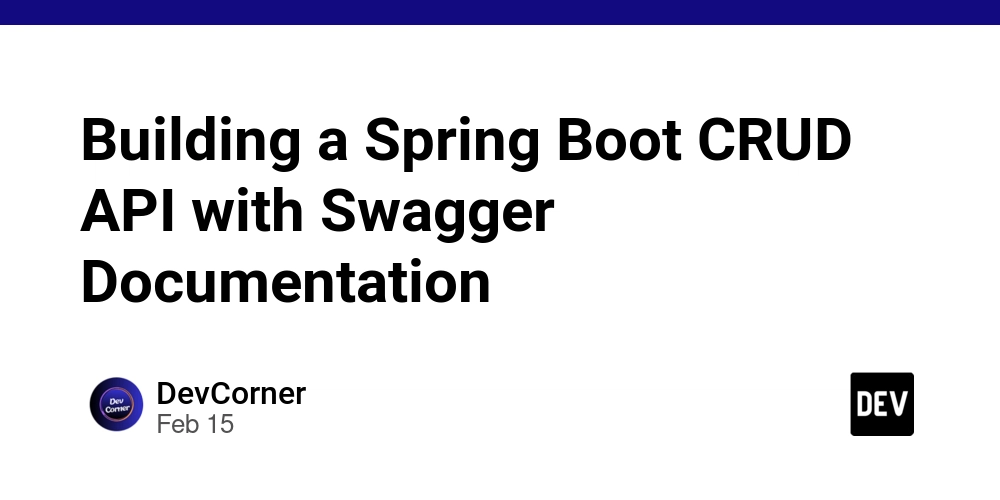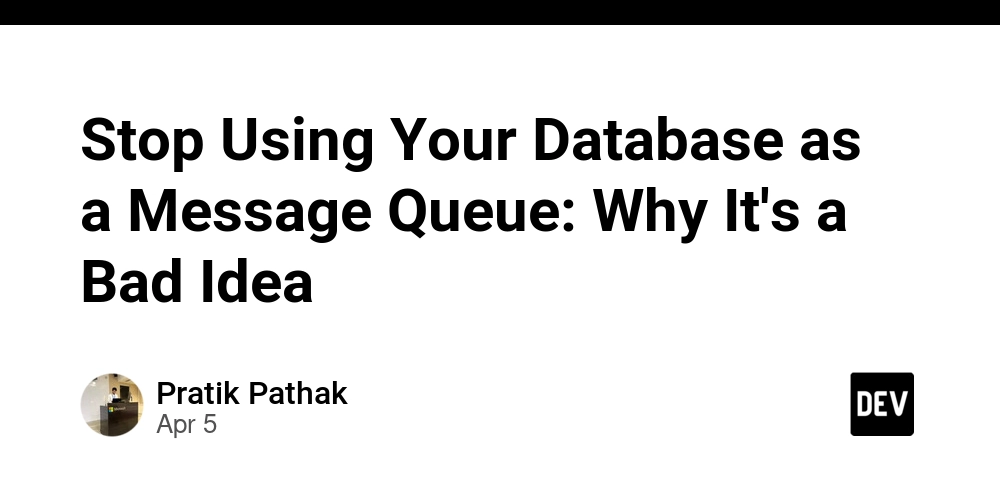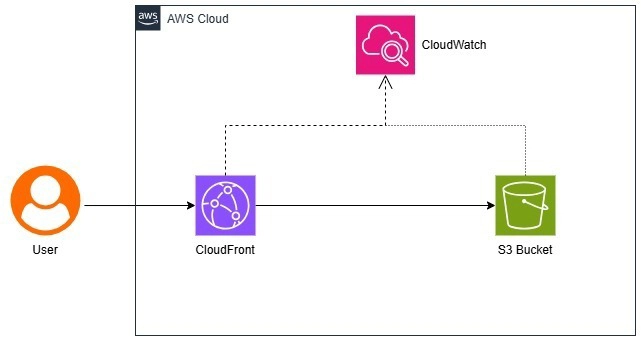Building a Spring Boot CRUD API with Swagger Documentation
Introduction Spring Boot is a powerful framework for building RESTful APIs quickly and efficiently. When building a CRUD (Create, Read, Update, Delete) API, it is crucial to document it properly so that developers can understand and interact with the API seamlessly. This is where Swagger comes in. Swagger (OpenAPI) provides an interface to visualize, interact, and test REST APIs without the need to manually write extensive documentation. In this blog, we will build a simple CRUD API using Spring Boot and integrate Swagger for API documentation. 1. Project Setup Maven Dependencies Add the following dependencies to your pom.xml file: org.springframework.boot spring-boot-starter-web org.springframework.boot spring-boot-starter-data-jpa com.h2database h2 runtime org.springdoc springdoc-openapi-starter-webmvc-ui 2.2.0 2. Creating the Entity Class Let's define a User entity class: @Entity @Data @NoArgsConstructor @AllArgsConstructor @Schema(description = "Entity representing a User") public class User { @Id @GeneratedValue(strategy = GenerationType.IDENTITY) @Schema(description = "Unique identifier of the user", example = "1", required = true) private Long id; @Column(nullable = false) @Schema(description = "Name of the user", example = "John Doe", required = true) private String name; @Column(nullable = false, unique = true) @Schema(description = "Email of the user", example = "john.doe@example.com", required = true) private String email; @Schema(description = "Role of the user", example = "Admin") private String role; } 3. Creating the Repository Interface Create a UserRepository interface extending JpaRepository: public interface UserRepository extends JpaRepository { } 4. Creating the Service Layer The UserService class will handle the business logic: @Service public class UserService { private final UserRepository userRepository; public UserService(UserRepository userRepository) { this.userRepository = userRepository; } public List getAllUsers() { return userRepository.findAll(); } public User getUserById(Long id) { return userRepository.findById(id) .orElseThrow(() -> new RuntimeException("User not found")); } public User createUser(User user) { return userRepository.save(user); } public User updateUser(Long id, User updatedUser) { User existingUser = getUserById(id); existingUser.setName(updatedUser.getName()); existingUser.setEmail(updatedUser.getEmail()); existingUser.setRole(updatedUser.getRole()); return userRepository.save(existingUser); } public void deleteUser(Long id) { userRepository.deleteById(id); } } 5. Creating the Controller Layer Define REST endpoints in UserController class: @RestController @RequestMapping("/api/users") @Tag(name = "User API", description = "CRUD operations for User management") public class UserController { private final UserService userService; public UserController(UserService userService) { this.userService = userService; } @GetMapping @Operation(summary = "Get all users") public ResponseEntity getAllUsers() { return ResponseEntity.ok(userService.getAllUsers()); } @GetMapping("/{id}") @Operation(summary = "Get user by ID") public ResponseEntity getUserById(@PathVariable Long id) { return ResponseEntity.ok(userService.getUserById(id)); } @PostMapping @Operation(summary = "Create a user") public ResponseEntity createUser(@RequestBody User user) { return ResponseEntity.ok(userService.createUser(user)); } @PutMapping("/{id}") @Operation(summary = "Update a user") public ResponseEntity updateUser(@PathVariable Long id, @RequestBody User user) { return ResponseEntity.ok(userService.updateUser(id, user)); } @DeleteMapping("/{id}") @Operation(summary = "Delete a user") public ResponseEntity deleteUser(@PathVariable Long id) { userService.deleteUser(id); return ResponseEntity.noContent().build(); } } 6. Application Properties Configure application.properties file: spring.datasource.url=jdbc:h2:mem:testdb spring.datasource.driverClassName=org.h2.Driver spring.datasource.username=sa spring.datasource.password=password spring.jpa.hibernate.ddl-auto=update 7. Running the Application Run the Spring Boot application and access the Swagger UI at: Swagger UI: http://localhost:8080/swagger-ui.html OpenAPI JSON: http://localhost:8080/v3/api-docs Conclusion This guide provided a step-by-step approach to

Introduction
Spring Boot is a powerful framework for building RESTful APIs quickly and efficiently. When building a CRUD (Create, Read, Update, Delete) API, it is crucial to document it properly so that developers can understand and interact with the API seamlessly. This is where Swagger comes in. Swagger (OpenAPI) provides an interface to visualize, interact, and test REST APIs without the need to manually write extensive documentation.
In this blog, we will build a simple CRUD API using Spring Boot and integrate Swagger for API documentation.
1. Project Setup
Maven Dependencies
Add the following dependencies to your pom.xml file:
2. Creating the Entity Class
Let's define a User entity class:
@Entity
@Data
@NoArgsConstructor
@AllArgsConstructor
@Schema(description = "Entity representing a User")
public class User {
@Id
@GeneratedValue(strategy = GenerationType.IDENTITY)
@Schema(description = "Unique identifier of the user", example = "1", required = true)
private Long id;
@Column(nullable = false)
@Schema(description = "Name of the user", example = "John Doe", required = true)
private String name;
@Column(nullable = false, unique = true)
@Schema(description = "Email of the user", example = "john.doe@example.com", required = true)
private String email;
@Schema(description = "Role of the user", example = "Admin")
private String role;
}
3. Creating the Repository Interface
Create a UserRepository interface extending JpaRepository:
public interface UserRepository extends JpaRepository<User, Long> {
}
4. Creating the Service Layer
The UserService class will handle the business logic:
@Service
public class UserService {
private final UserRepository userRepository;
public UserService(UserRepository userRepository) {
this.userRepository = userRepository;
}
public List<User> getAllUsers() {
return userRepository.findAll();
}
public User getUserById(Long id) {
return userRepository.findById(id)
.orElseThrow(() -> new RuntimeException("User not found"));
}
public User createUser(User user) {
return userRepository.save(user);
}
public User updateUser(Long id, User updatedUser) {
User existingUser = getUserById(id);
existingUser.setName(updatedUser.getName());
existingUser.setEmail(updatedUser.getEmail());
existingUser.setRole(updatedUser.getRole());
return userRepository.save(existingUser);
}
public void deleteUser(Long id) {
userRepository.deleteById(id);
}
}
5. Creating the Controller Layer
Define REST endpoints in UserController class:
@RestController
@RequestMapping("/api/users")
@Tag(name = "User API", description = "CRUD operations for User management")
public class UserController {
private final UserService userService;
public UserController(UserService userService) {
this.userService = userService;
}
@GetMapping
@Operation(summary = "Get all users")
public ResponseEntity<List<User>> getAllUsers() {
return ResponseEntity.ok(userService.getAllUsers());
}
@GetMapping("/{id}")
@Operation(summary = "Get user by ID")
public ResponseEntity<User> getUserById(@PathVariable Long id) {
return ResponseEntity.ok(userService.getUserById(id));
}
@PostMapping
@Operation(summary = "Create a user")
public ResponseEntity<User> createUser(@RequestBody User user) {
return ResponseEntity.ok(userService.createUser(user));
}
@PutMapping("/{id}")
@Operation(summary = "Update a user")
public ResponseEntity<User> updateUser(@PathVariable Long id, @RequestBody User user) {
return ResponseEntity.ok(userService.updateUser(id, user));
}
@DeleteMapping("/{id}")
@Operation(summary = "Delete a user")
public ResponseEntity<Void> deleteUser(@PathVariable Long id) {
userService.deleteUser(id);
return ResponseEntity.noContent().build();
}
}
6. Application Properties
Configure application.properties file:
spring.datasource.url=jdbc:h2:mem:testdb
spring.datasource.driverClassName=org.h2.Driver
spring.datasource.username=sa
spring.datasource.password=password
spring.jpa.hibernate.ddl-auto=update
7. Running the Application
Run the Spring Boot application and access the Swagger UI at:
- Swagger UI: http://localhost:8080/swagger-ui.html
- OpenAPI JSON: http://localhost:8080/v3/api-docs
Conclusion
This guide provided a step-by-step approach to building a Spring Boot CRUD API and integrating Swagger for API documentation. With this setup, you can create scalable REST APIs with self-generated documentation for better maintainability and developer experience.












































































































































































![[The AI Show Episode 142]: ChatGPT’s New Image Generator, Studio Ghibli Craze and Backlash, Gemini 2.5, OpenAI Academy, 4o Updates, Vibe Marketing & xAI Acquires X](https://www.marketingaiinstitute.com/hubfs/ep%20142%20cover.png)



























































































































![[FREE EBOOKS] The Kubernetes Bible, The Ultimate Linux Shell Scripting Guide & Four More Best Selling Titles](https://www.javacodegeeks.com/wp-content/uploads/2012/12/jcg-logo.jpg)



![From drop-out to software architect with Jason Lengstorf [Podcast #167]](https://cdn.hashnode.com/res/hashnode/image/upload/v1743796461357/f3d19cd7-e6f5-4d7c-8bfc-eb974bc8da68.png?#)





































































































.png?#)





.jpg?#)































_Christophe_Coat_Alamy.jpg?#)







































































































![Rapidus in Talks With Apple as It Accelerates Toward 2nm Chip Production [Report]](https://www.iclarified.com/images/news/96937/96937/96937-640.jpg)








































































































































